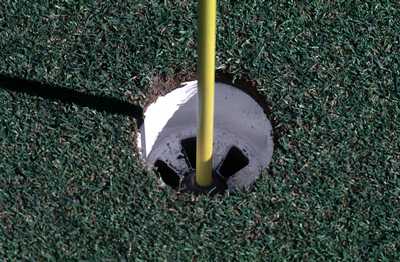How to Build a Putting Green in Your Backyard
Building a putting green is going to help you improve your short game in golf, but you might not know that practice putting greens also add value to your property. So learning how to build a putting green from this online tutorial is not only going to take strokes off your score, but let you cut costs in adding value to your home’s retail value.
You don’t have to be a master greenskeeper to know how to build a putting green in your backyard, either. Between putting green kits and options ranging from synthetic putting surfaces to a variety of special grass options, you can design your own golf hole made to order, without costing thousands of dollars. Once you have your own private recreational putt surface, you can practice with the putter every day after work and greatly improve the trickiest, touchiest part of any amateaur golfer’s game.
Select a Shape for Your Green
Look over your property and decide how much room you have to play with. This helps you determine how many putting greens are feasible, while giving you an idea for the shape of your green. You probably want putting surfaces that offer different challenges, or one single putting surface with a challenge or two.
That is, you want to be able to practice straight-in putting on a flat surface, but you probably want to practice putting up, down and across an incline, too. Luckily, one hole helps you do all of that. Selected the size of the green is important, because you can only practice putts the lengths of your green, so determine how long of a putt you want to practice.
Find a Level Location
The basic wish for most golfers is practicing their golf stroke or putting stroke under optimal conditions, with the idea that they can reproduce that swing under less than optimal conditions later. So if you are installing one hole, you probably want to install a flat surface on your green, so you can hone your ability to judge distances and perfect a smooth stroke.
If you are building one hole, find a level part of your back yard and make this your green. Even a slight grade is going to wreak havoc with golf shots, so find the most level portion of your yard to place this green. Once you do, clear the area around that spot to set aside that size landscape for your green.
Sketch an Outline
Using either landscape spray paint or masonry chalk, sketch an outline of your putting green as a point of reference. Take a long hard look at the outline and decide if this is where you want your putting surface.
Drainage is Important
Drainage is key in getting a pristine putting surface. This means your green needs to be raised slightly above the rest of your yard. You don’t want water pouring from some other portion of the yard onto your green, anytime it rains.
Add Sand to the Surface

How to Build a Putting Green in Your Backyard
To help with drainage, you need to add sand content to the soil, to soak up water. Some people who want to go all-out end up bringing in a sand base. Others use compacted crushed gravel with limestone or stone dust added on top, to help drainage issues.
This is an important step. If you want that sculpted, manicured look that golf course greens have, you want to study up and choose the right surface. This may cost some money, too.
Choose a Turf
To have a smooth carpeting, you need a grass with fine blades. Read about Tifgreen and Tifdwarf and see if either of these are feasible for your landscaping skills and budget. If not, Kentucky Bluegrass and Fescue are options.
If you want that professional look, you’ll want to go with sodding or plugs. If that’s too intensive for you and you could care less about professional quality putting surfaces, continue apace by landscaping the lawn you already have. If so, remember to pay attention to drainage issues and add something to help your soil soak up water.
Cut Grass Often – Water Grass Often
To have a perfect putting surface, you’ll need to cut your grass often and water consistently. Skimp on either of these and your putting green won’t look like the putting surface you want.
Artificial is a Good Alternative
If all of that sounds like an immense pain or a waste of money, consider using artificial turf for your backyard putting green. The turf is going to cost a little, but it’s a one-time expense and is a realistic alternative.
Building the green is much easier with artificial grass. Maintenance is a hundred times easier. Pay attention to the soil underneath artificial lawn, though, because this helps keep your green in the shape you want it.
Dig Holes for Your Backyard Green
Dig a 4-inch hole for your green. Glue a cup into your hole with fast-drying concrete. Some people buy a hole cutter (low cost $125) and move their hole around every once in a while, moving the cup along with it. Decide whether that price is worth it, but I couldn’t find a less expensive option on eBay in a quick search, though Amazon had a golf hole cutter for just over $120.
Building a Backyard Putting Green
Once you know how to build a putting green in your backyard, you can show your envious neighbors how to do the same. Or better yet, don’t tell anyone until next spring, when you can show off your new, improved short game to your buddies at your favorite golf course.
